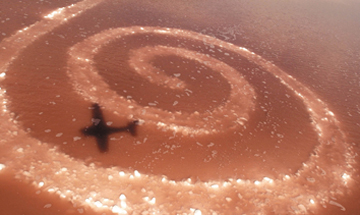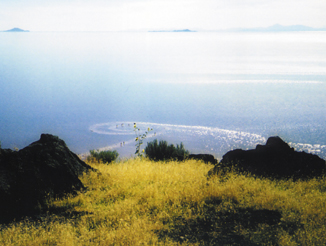
Geotimes Home | AGI Home | Information Services | Geoscience Education | Public Policy | Programs | Publications | Careers

 Back again by climatic
demand is artist Robert Smithson’s 1970 construction Spiral Jetty.
Performing only under drought conditions in the Great Salt Lake of Utah, the Jetty
recently reappeared after years of submergence. It features 3 million-year-old
olivine basalt from the adjacent shoreline of Rozel Point. The black rock, accented
with white salt crystals, is bathed in red water unique to the Great Salt Lake’s
northern region, where red algae, brine shrimp and bacteria thrive in the salt-saturated
environment.
Back again by climatic
demand is artist Robert Smithson’s 1970 construction Spiral Jetty.
Performing only under drought conditions in the Great Salt Lake of Utah, the Jetty
recently reappeared after years of submergence. It features 3 million-year-old
olivine basalt from the adjacent shoreline of Rozel Point. The black rock, accented
with white salt crystals, is bathed in red water unique to the Great Salt Lake’s
northern region, where red algae, brine shrimp and bacteria thrive in the salt-saturated
environment.  While the sculpture
was designed to disappear and reappear with rise and fall of the lake level, this
intermittent quality of the show is under negotiation. The Dia Center for the
Arts in New York City recently received rights to the artwork from the Smithson
estate, and is contemplating building up the Spiral Jetty to extend its
performance time. In the last 10,000 years, sedimentary records indicate the lake
elevation has fluctuated about 40 feet, says geologist Bill Case of the Utah Geological
Survey. But it only takes a few feet to submerge the Jetty beyond visibility.
While the sculpture
was designed to disappear and reappear with rise and fall of the lake level, this
intermittent quality of the show is under negotiation. The Dia Center for the
Arts in New York City recently received rights to the artwork from the Smithson
estate, and is contemplating building up the Spiral Jetty to extend its
performance time. In the last 10,000 years, sedimentary records indicate the lake
elevation has fluctuated about 40 feet, says geologist Bill Case of the Utah Geological
Survey. But it only takes a few feet to submerge the Jetty beyond visibility.
 |
Geotimes Home | AGI Home | Information Services | Geoscience Education | Public Policy | Programs | Publications | Careers |